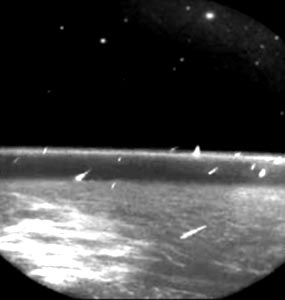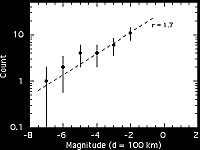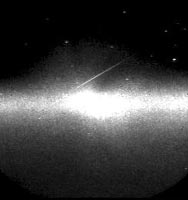|
Leonid MAC |
| home |
| View the shower |
| Mission Brief |
| Science Update |
| Media Brief |
| links |
LEONID DAILY NEWS: November 14, 2000

Figure left: A composite of Leonid meteor images recorded by a CCD camera
onboard the MSX satellite. Right: the distribution of meteor magnitudes derived
from these records. Third figure on the page shows one CCD frame from the narrow
angle camera with one Leonid meteor just above the airglow.
METEOR SHOWER FROM SPACE
The view from space offers a unique perspective on meteors.
In a recent issue of Earth, Moon and Planets, Peter Jenniskens and David Nugent
at NASA Ames Research Center,
Ed Tedesco at TerraSystems, Inc., and Jayant
Murthy at the Johns Hopkins University
report on the first observations of a Leonid meteor shower from space.
Space based observations are uniquely suited for spectroscopy of meteors at
wavelengths that are inaccessible from the ground. Space based observations are
also capable of monitoring a
large surface area for influx of bright Leonid fireballs. The 1997 Leonid shower was
rich in such bright meteors and numerous detections were made.
The image to the right is a composite of some of the 29 meteors filmed during a 48 minute
period at the peak of the 1997 Leonid shower. The star background is the constellation
of Aries, which gives a sense of scale. The images were taken with the
UVISI instrument onboard the Midcourse Space Experiment satellite (MSX). MSX is
a Ballistic Missile Defense Organization project. The Johns Hopkins Univeristy Applied
Physics Laboratory developed, integrated, and operated MSX and the
Ultraviolet and Visible Imagers and Spectrographic Imagers (UVISI) instrument that was
used for the observations.
The satellite was programmed to watch the limb of the Earth, where the rate of meteor
detections is expected to be
highest, because the largest surface area is covered in a single field of view.
In some of the narrow field images it is clearly seen that the
fast Leonid meteors ablated above the layer of the airglow at about 87 km altitude,
where most other meteors ablate. Meteors that are seen below the airglow layer
are in fact closer to the satellite. Meteors in the background are significantly dimmed
and do not show the gradual rise in intensity that is clear in other images. This made
it possible to determine uniquely the distance to all meteors and measure their
absolute brightness, defined as the meteor's brightness if it was at 100 km distance.
The observations were analysed to determine the rate of bright meteors incident on the
Earth at the time of the shower.
The limiting absolute magnitude for limb observations of
Leonid meteors was measured at Mv = -1.5 magn. The Leonid shower magntiude population
index was measured at N(m+1)/N(m) = 1.6ÿý0.2 down to Mv = -7 magn.,
with no sign of an upper mass cut-off (Full paper - PDF).
Nov. 14 - Meteor shower from space Nov. 13 - Organic fingerprint Nov. 12 - Train airglow chemistry Nov. 11 - Hard bits and persisting glows Nov. 10 - Meteoroid debris detected Nov. 09 - New meteor picture Nov. 08 - Spin city Nov. 07 - Meteors affect atmospheric chemistry Nov. 06 - Listen to this! Nov. 04 - Fear of heights? Nov. 03 - The pale (infra-red) dot Nov. 02 - Twin showers Nov. 01 - Leonids approaching Earth Oct. 31 - Prospects for Moon Impact Studies Oct. 30 - Comet dust crumbled less fine Today's news
| ||



